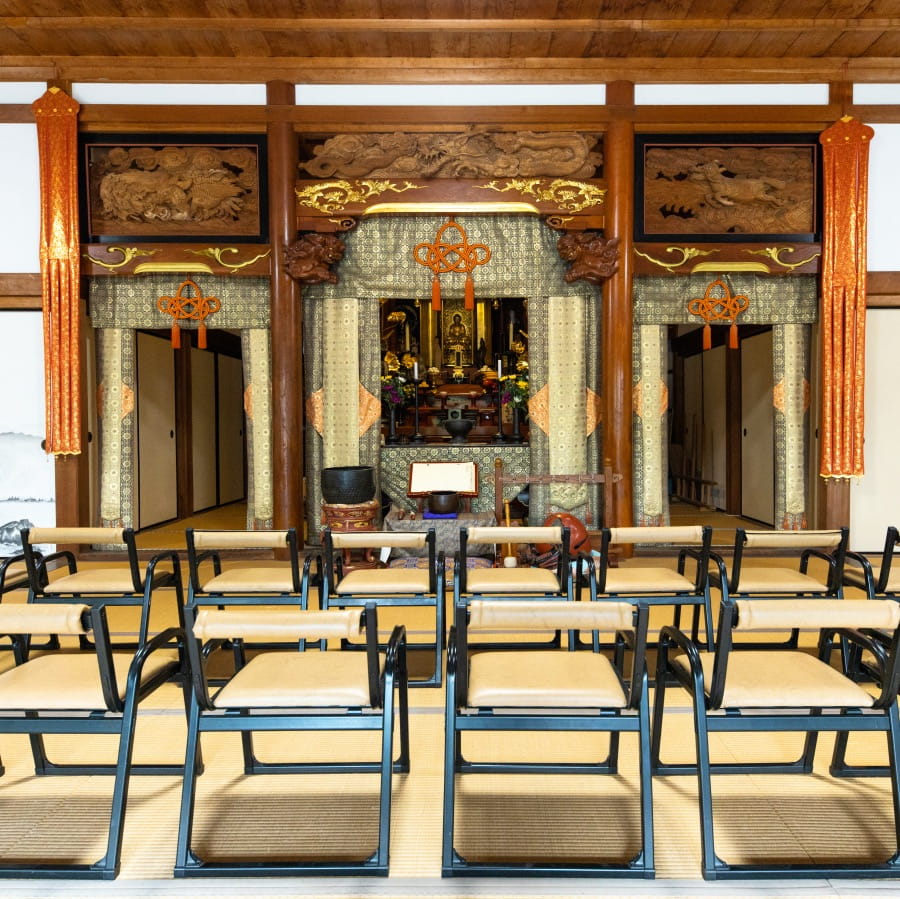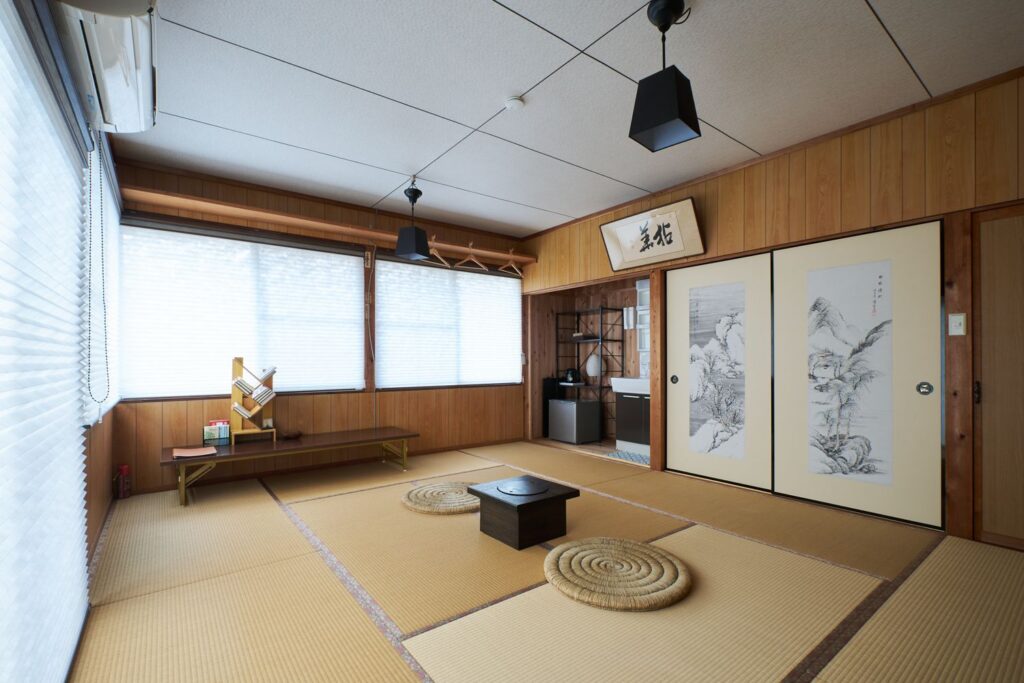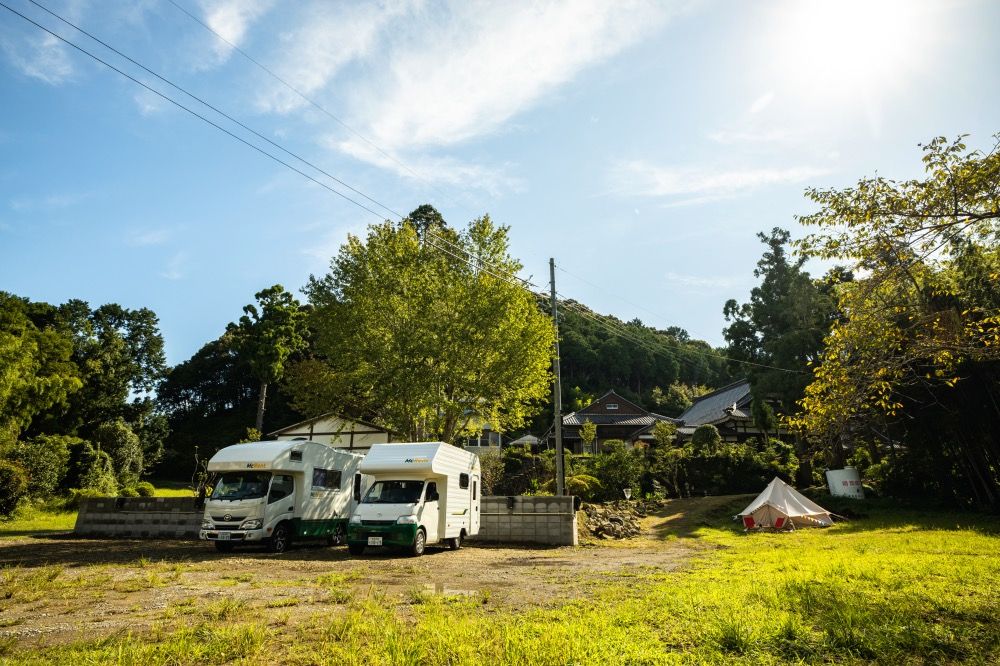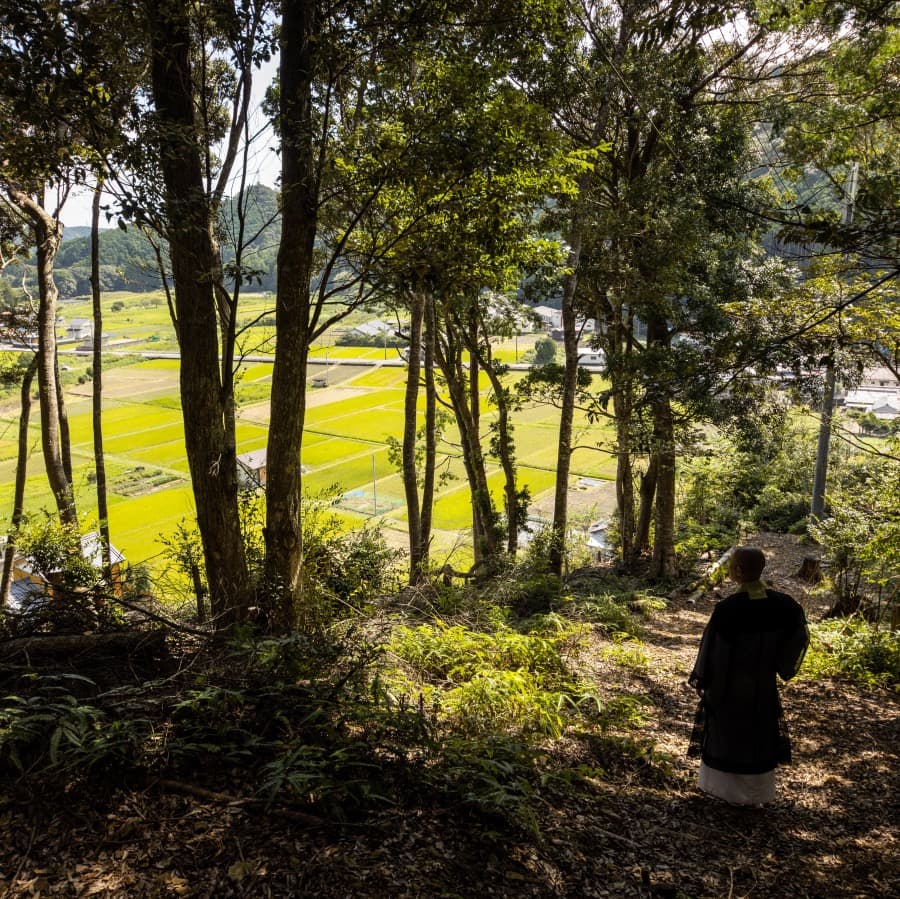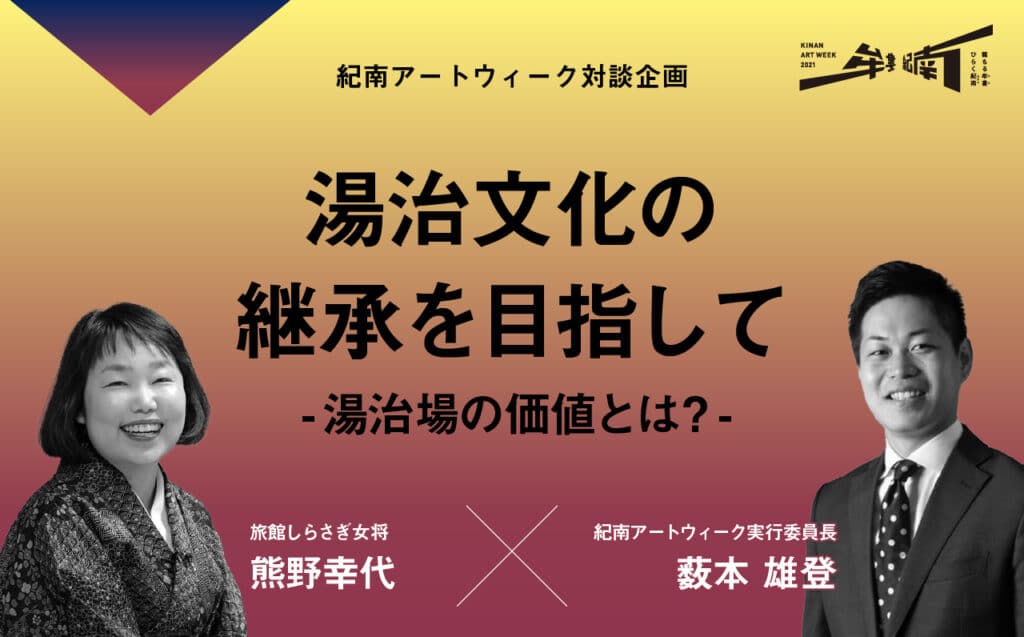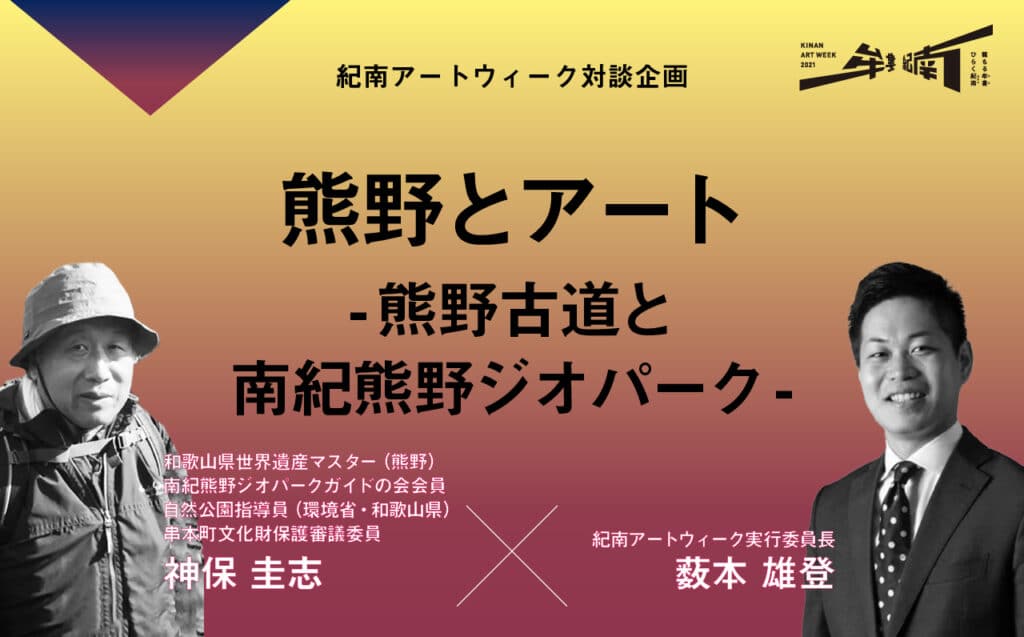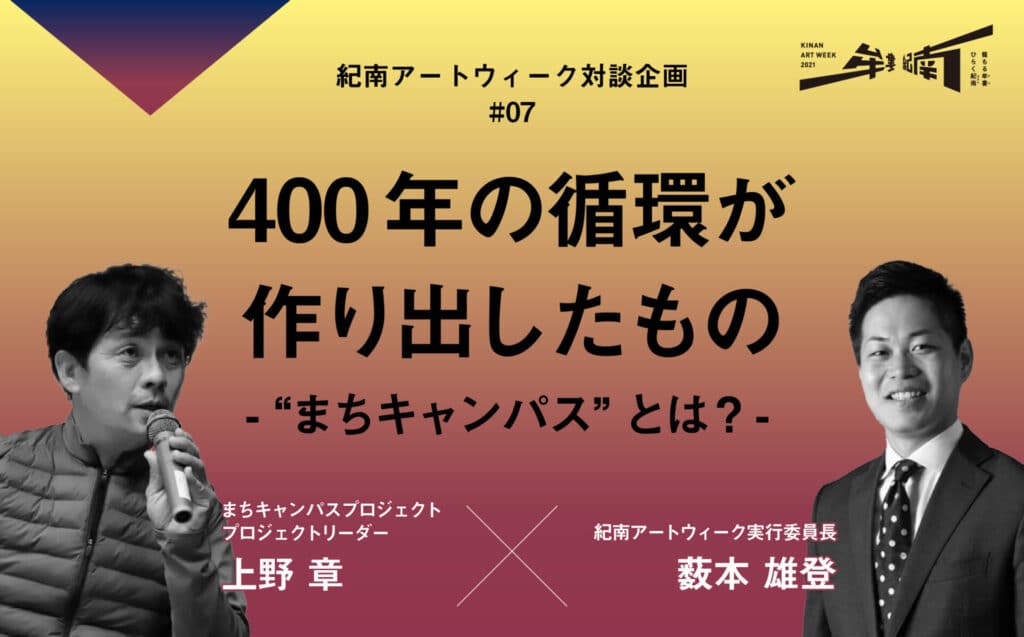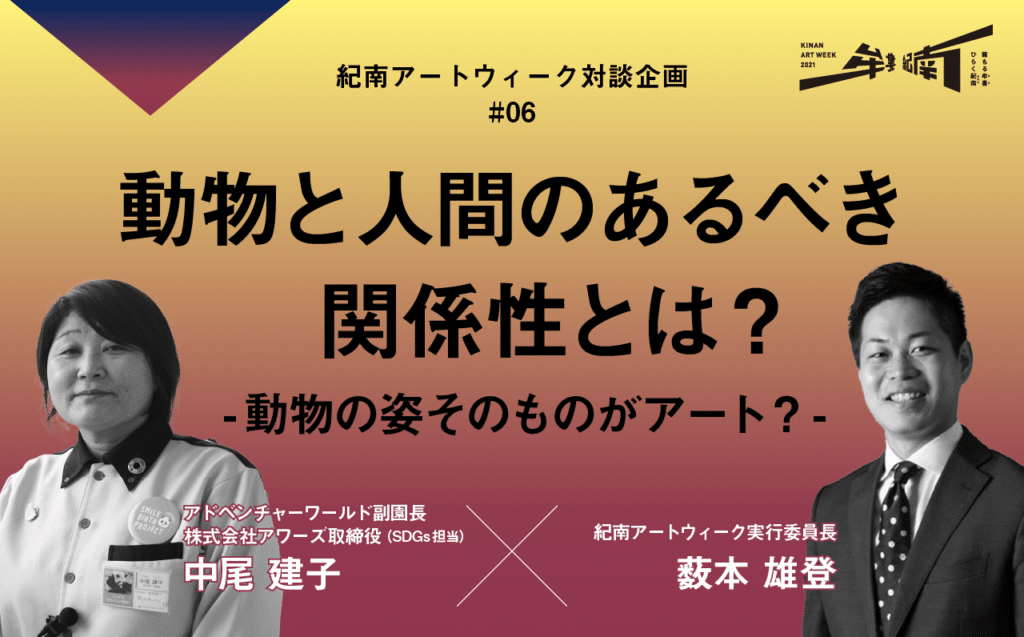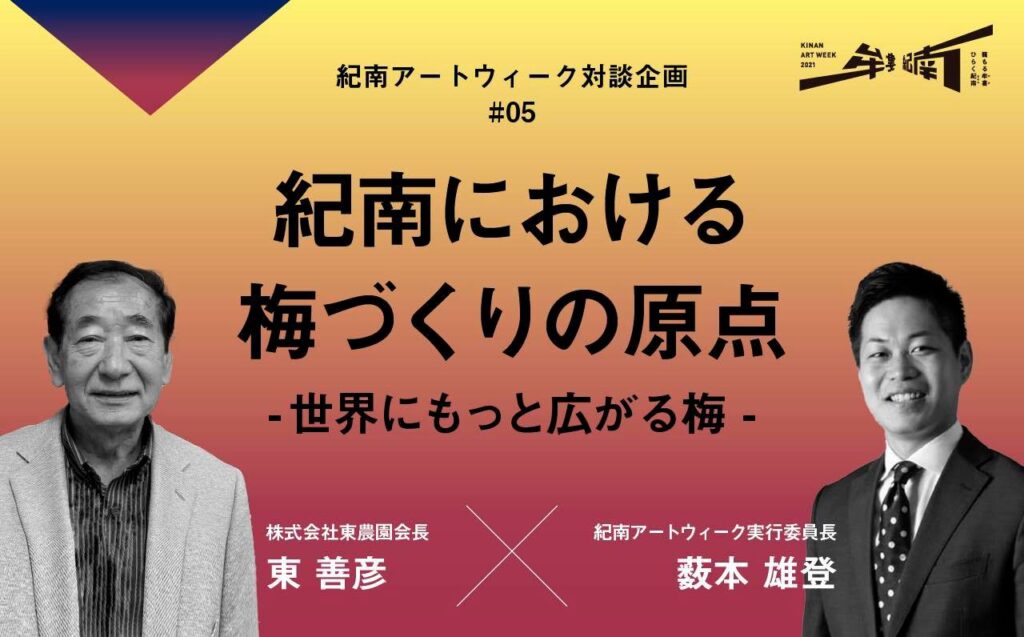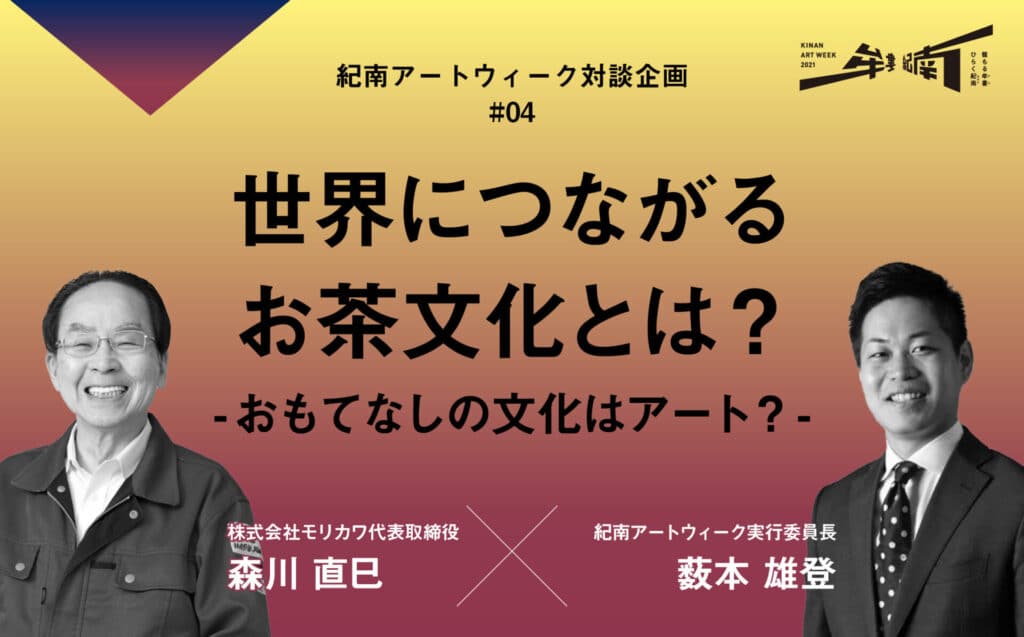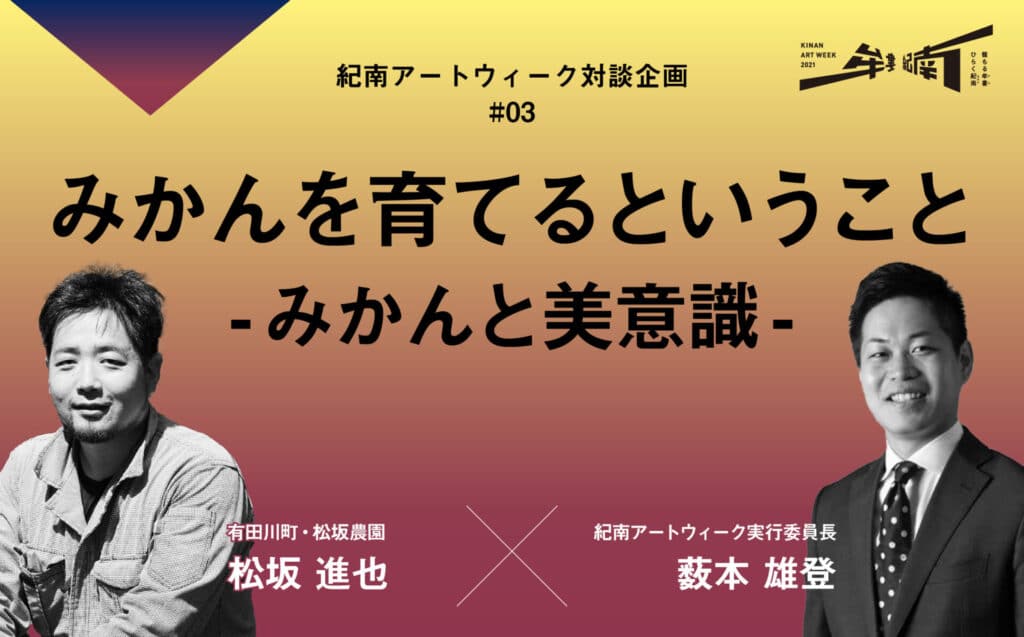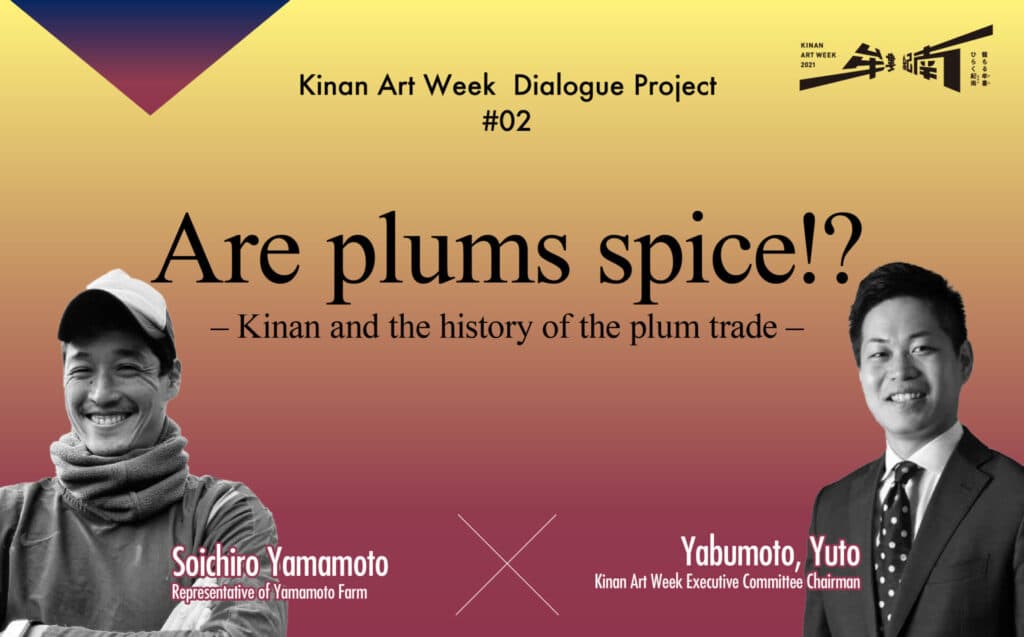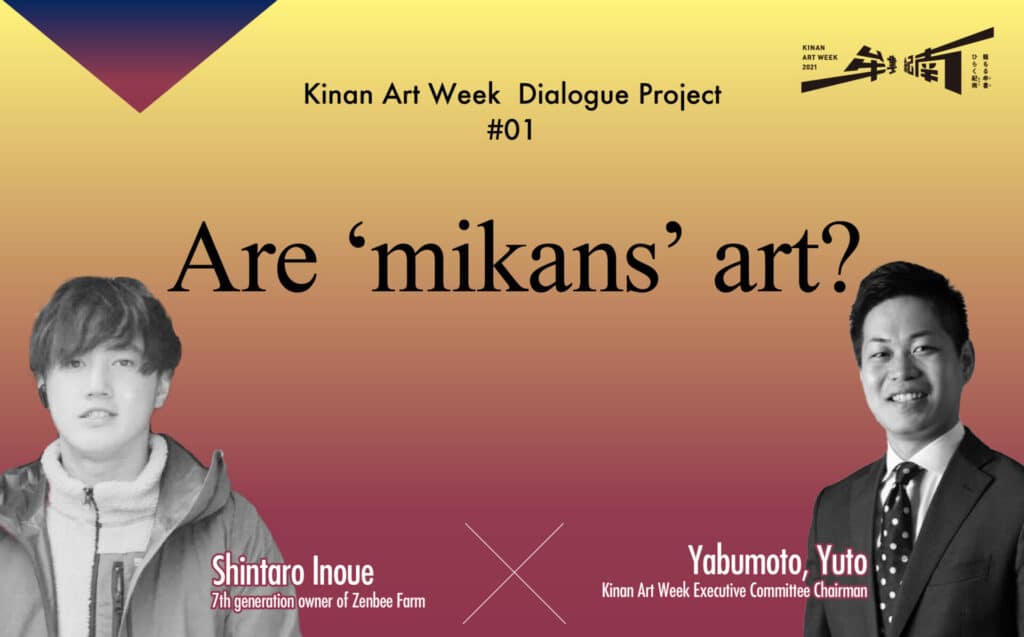
Dialogue project #10 “The value and role of the temple, And art and the future”
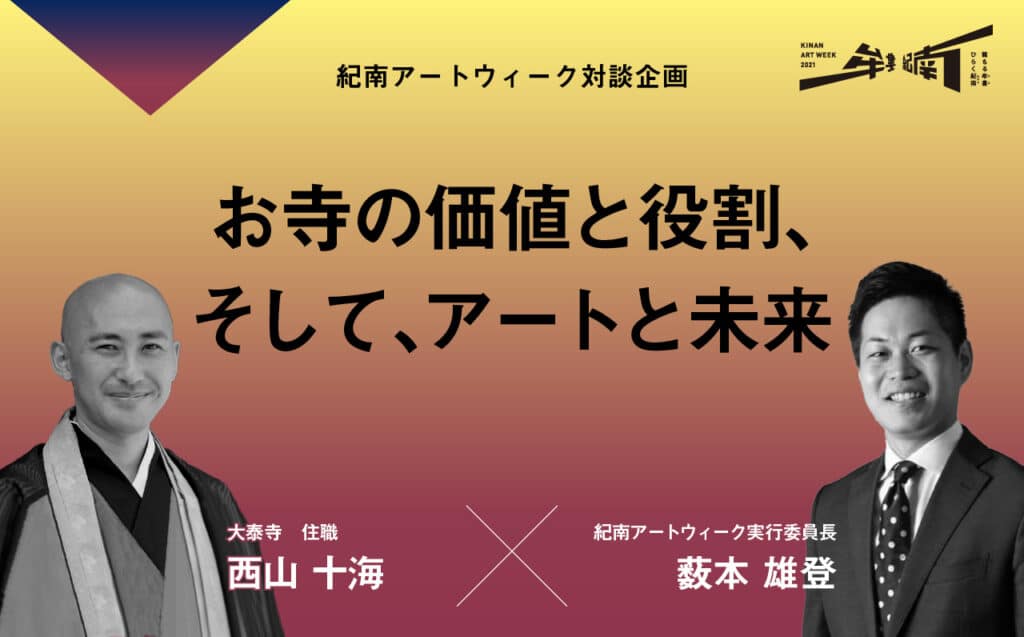
Kinan Art Week Dialogue project #10
Guest :
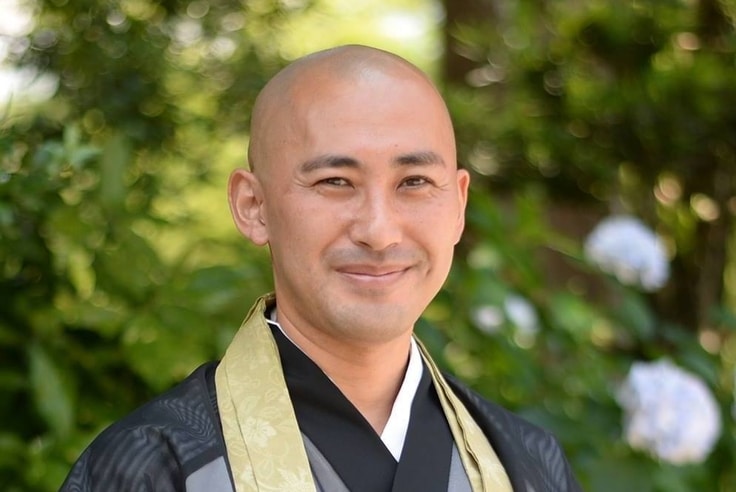
Chief priest of Dataiji Temple
Tomi Nishiyama
Chief priest of Daitaiji Temple, a 1200 year old temple located in Nachikatsuura Town, Wakayama Prefecture.
He has been working on sustainable temple practices such as temple stays, temple vacations, campsites and RV parks.
https://oterastay.com/daitaiji/
Interviewer :
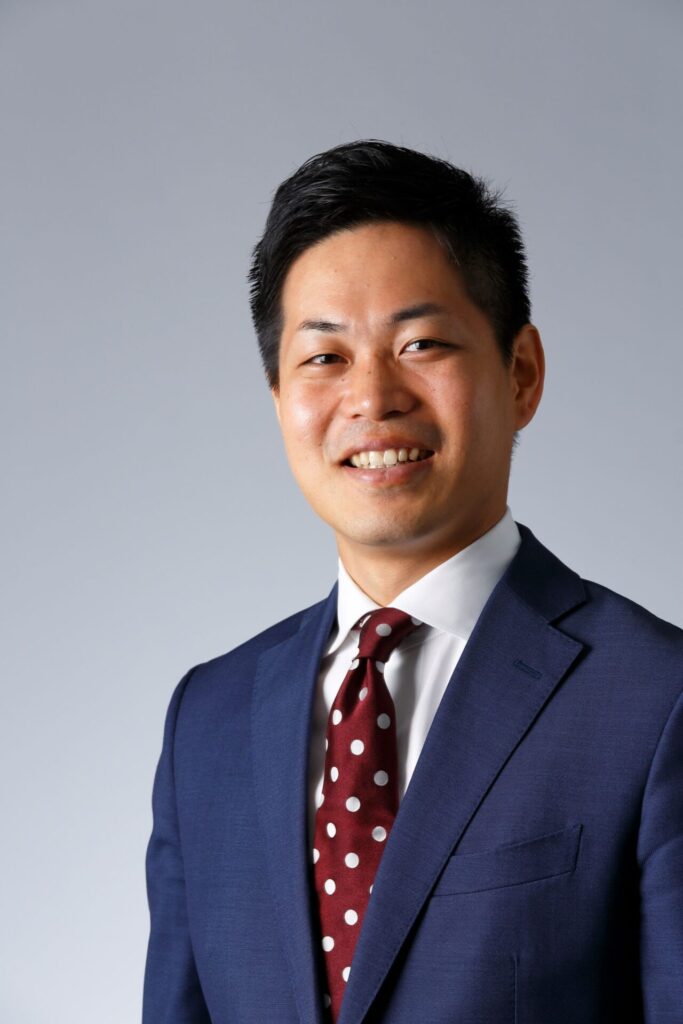
Kinan Art Week Executive Committee Chairman
Yuto Yabumoto
Editing :
Kinan Editorial Department by TETAU
https://good.tetau.jp/
The value and role of the temple, And art and the future
<Table of Contents>
1. Introduction of the abbot of Nishiyama
2. History of conversion and demilitarisation
3. The relationship between religion and art
4. Dataiji’s cutting-edge approach
5. Temple = safe place
6. Towards the dissolution of religious institutions
7. How can we preserve the temple for the future?
1. Introduction of the abbot of Nishiyama
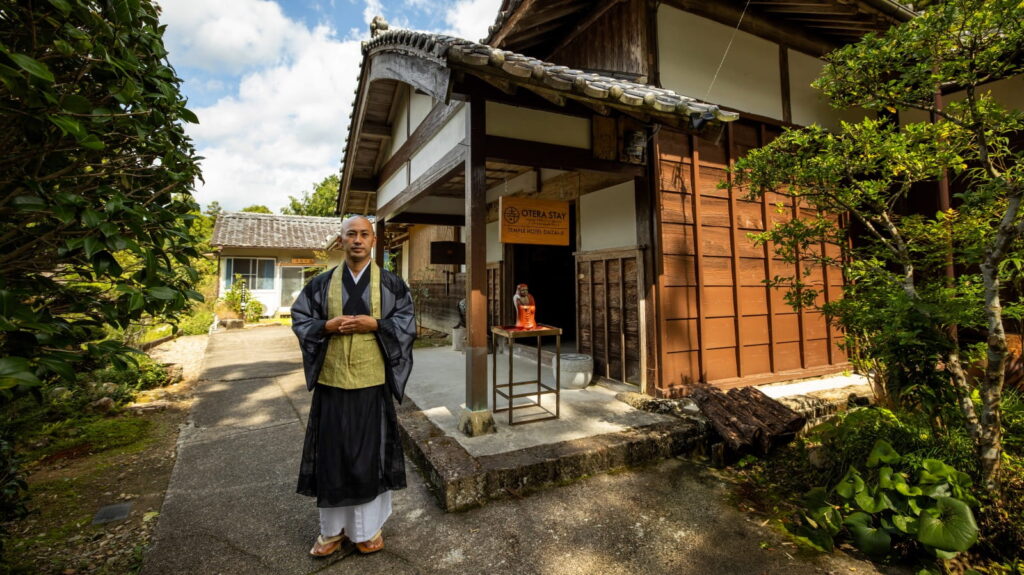
Yabumoto:
Thank you very much for your time.
Today we would like to ask you about the functions and roles of temples in Kinan, and about the future and its prospects. First of all, could you please introduce yourself as the abbot?
Mr. Nishiyama:
My name is Tomi Nishiyama. I am the abbot of a temple called Daitaiji in Nachikatsuura-cho, Wakayama Prefecture. The temple is said to have been founded by Saicho, the founder of Mount Hiei. I was born as a son of Kaizouji Temple, which is a branch temple of Daitaiji Temple. In fact, I used to be a junior high school teacher in Tokyo, but after the great flood in the Kii Peninsula about 9 years ago, I came back to my hometown and I don’t know what happened, but the role of the abbot of the temple came to me. Now I’m trying to lower the threshold of this temple and make it more sustainable, so that more people can use and enjoy it.
Yabumoto:
So it was the floods that brought you back to your hometown?
Mr. Nishiyama:
When I was working as a teacher, I used to go to work at about 7am and work until about 10pm, so I was very busy. When I had doubts about the way I was working and living, there was a big flood in my hometown and I felt it was time to go back to my hometown and contribute something, so I came back to Kinan and Nachikatsuura.
Yabumoto:
As I recall, you were a teacher and DJ in Tokyo, weren’t you? I would like to hear about that.
Mr. Nishiyama:
That’s right (laughs). When I was taking my university entrance exams, Ura-Harajuku fashion was very popular, so I was interested in that kind of thing at first. Then I got into street dance, and from there I started to DJ this time. In particular, I like jazz the most, but I also got into Latin, Brazilian music and soul, which are close to jazz.
Yabumoto:
That’s interesting! It’s not easy to find a priest like that, is it?
Mr. Nishiyama:
Not really. Some priests make their own music.
Yabumoto:
Indeed, it’s been up on YouTube recently. Have you seen the video * of the Heart Sutra and the Beat Box? It’s amazing, that world view. I think people all over the world are watching it.
*Reference: Heart Sutra BeatboxRemix(Yogetsu Akasaka,YouTube)
Mr. Nishiyama:
Some people say that the sutra itself is the first rap song in Japan, and if you say that, I think that’s true. If you say so, I think it’s true, because the words are strung together in a rhythm.
Yabumoto:
I think you might be right.
You mentioned earlier that you felt uncomfortable with the way you were working and living, is that the reason why you have been taking various actions since you came back to your hometown?
Mr. Nishiyama:
I was born as a child of the Rinzai sect, a Zen sect, and naturally I became a priest there and studied Zen, but I felt that Zen was not only for my benefit but also “for the benefit of others”, so I decided to spread it. Zen is quite interesting.
Zen is more like a philosophy of life than a religion. It is a way of thinking that delves into the inner life of the individual, rather than trying to gain followers and grow a cult, and so I believe that it really does have “useful wisdom for people”.
2. History of conversion and demilitarisation
Yabumoto:
If you look back at the history of Tai Taiji, it was originally a Tendai sect temple. What happened from there that made you change to the Rinzai sect?
Mr. Nishiyama:
Daitaiji Temple was converted to Buddhism in the Edo period, after the Kishu Tokugawa family came to power. Daitaiji, which was a Tendai sect, was originally a kind of branch temple of Nachi-san Seiganto-ji *. Around the temple there were manors of Mt. Nachi, and Daitaiji was there to manage them. It was the “purse” of Nachisan. When the temple was taken away, Nachisan was weakened and converted to the Rinzai sect, which was more like a samurai sect.
*Reference: Nachisan Seigantoji Temple (World Heritage SiteNachikatsuura Tourism Organization website)
Yabumoto:
I see. In those days, it was the time of the samurai, so they were no match for the power and military might of the time.
Mr. Nishiyama:
At that time, the samurai were struggling to find a way to suppress the power of the temples and shrines. The temples had lots of rice paddies, and some of them had monopoly rights over sake, miso and soy sauce. It seems that they were economically rich, and moreover, they had monks and soldiers, and whenever something happened, they became the ones who were on the verge of “Buddha’s punishment”.
In addition to this, there were also power struggles between religions and sects, which may have had something to do with it. There were also battles among the monks of Nachi-san. It was not only a struggle for power and wealth, but also a struggle for power among the samurai, as they brought in samurai to win. Perhaps the “militarization” went too far in such a way.
Yabumoto:
When I hear the word “armed”, I think of something like the Musashibo Benkei statue in Tanabe.
Mr. Nishiyama:
That’s right. There were many armed monks of that image in the temples and shrines at that time.
But if you think that it took three war heroes – Nobunaga Oda, Hideyoshi Toyotomi and Ieyasu Tokugawa – to finally achieve the ‘demilitarisation’ of temples, it seems to me that it was a major long-term project. If you look around the world, there are many places where religions have not yet been demilitarised. I don’t think it will appear in Japanese history books, but I think the demilitarisation of religious forces was a significant project.
Yabumoto:
There were religious wars, so the historical background may be different, but it was a period like that. In the context of art, I have been steadily collecting ukiyoe, and although there are many theories, I am strongly attracted to the world of ukiyoe as a symbol of peace, from Iwasa Matabei in the Warring States period to the Edo period and before the war.
Mr. Nishiyama:
Yes, it is. I don’t think it’s a pretty world.
It was and still is the case that there will be forces that clash in search of land and interests. But after demilitarisation, we couldn’t take land by fighting, so we had to win congregations purely by our ideas, philosophy and teachings themselves.
When it comes to gaining followers, the Rinzai sect, which was once a samurai-orientated sect, underwent a major transformation during the Edo period. A famous monk named Hakuin Keikaku revolutionised the Rinzai sect with the power of art. For example, he wrote hanging scrolls and used them as “visual material” as a means of propagation.
Yabumoto:
Hakuin is a true artist. I have been to several Hakuin exhibitions. For me, the image of an artist is rather stronger. Besides, I think art is a way to explain things that cannot be put into words, just because the medium is different.
Mr. Nishiyama:
That’s exactly what he did, I think he made it easier for people to understand the ideas and teachings by making them into hanging scrolls, in the same way that it’s easier to understand PowerPoint when you have different images and put them together in a table. Shirakakushi has also created sutras in Japanese (colloquial language) and Dharma talks that are accessible to the general public.
As a result, I think that the demilitarisation of the temples and shrines was good for Buddhism in Japan, because Buddhism was transformed to be closer to the people.
3. The relationship between religion and art
Yabumoto:
I think there is a close relationship between temples and art, as in the case of Hakushin. Especially in Thailand, Cambodia and Myanmar, where I live, religious art is very much alive and has a strong presence in the city. In this sense, religion and art are very close and have a high affinity.
Mr. Nishiyama:
Originally, temples were closely associated with art in many ways, and in the Muromachi period they became places to display and house cutting-edge art. In the Edo period, they provided a place for artists to stay, and in return, the artists left behind some amazing works of art as a thank you.
Yabumoto:
You are truly an artist-in-residence *1. The works of Rasetsu Nagasawa at Sodoji Temple* in Tomita and Muryouji Temple * in Kushimoto are just such examples.
*1 The artist stays on the land to create the work.
Artist in Residenceartscape)
*Reference: NanchangzanSodoji TempleNPOKumano Mandala)
*Reference: About Muryouji Temple (Kishu-KushimotoMuryouji Temple Website)
Mr. Nishiyama:
It’s a pity that there are no records of the temple in Dataiji, but originally there were works by Soga Shobaku. I think that if Nagasawa Rasetsu had come to Muryouji, he would have come to Daitaiji too. …… But it’s interesting to imagine it like this.
Yabumoto:
They were both truly visionary painters! Ashiketsu was an elite painter, but he came to Kinan from Kyoto, and in a way, he exploded his talent by coming to Kinan, where he was free and relaxed.
I think there is a connection with the “temple work “* that you do at Daitaiji. I think it would be even more attractive if we could tell the story in that way.
*Reference; temple work (Dai Taiji website)
Mr. Nishiyama:
When I tell people that temples used to be the cutting edge of art, they are really surprised. I think it would be interesting to break down the image that people have of temples being old-fashioned. I think the real appeal of Zen is that it breaks down stereotypes, so it would be great if we could make more use of the many temples we have with free ideas.
I think that good things need to be constantly updated. Some people say, “Isn’t the sutra itself the first rap? So I think it’s necessary to convert it into something modern.
Yabumoto:
I see. By the way, is there a possibility that the abbot himself will become an artist?
Mr. Nishiyama:
I’m not a person who creates, I think I just create an environment where people who want to create can do so.
Originally, the temple was a nursery, but now the boy who rents the wooden school building says he wants to turn it into a café. If we can turn it into a café, I’m thinking of renting it a few times a month and doing something there.
Yabumoto:
Isn’t it great! If you’d like, why don’t we do something together at the next Kinan Art Week? I think it would be interesting to recreate the world that the priest wants to create.
Mr. Nishiyama:
Of course! I look forward to working with you!
4. Dataiji’s cutting-edge approach

Yabumoto:
We understand that you are working on a cutting-edge project at Dataiji.
Mr. Nishiyama:
When I took over this temple, the mountain and bamboo forest were in a terrible state of disrepair. The cultural assets had not been repaired and an arm of a Buddha statue was missing, it was just a very bad situation. We wanted to make it so that people wouldn’t be embarrassed to visit us, but it was difficult to rely on our parishioners and make do with the income from offerings. The danka system has its advantages and disadvantages, and there is a polarisation between those who are danka and those who are not danka.
Yabumoto:
A parishioner system is like a membership system, isn’t it?
Mr. Nishiyama:
That’s right. In the old days, during the Edo period, there was a system called the “Terauke system “*2, which gave temples the function of managing family registers and keeping track of their personnel. People in the village belonged to the temple located in the village, and this led to the current danka system.
In the past, there was no problem because the whole community was a temple family, but in recent years, due to population movement, there has been a polarisation within the community between those who have moved here and those who have always lived here. This has made me wonder if it would be better to have more people familiarise themselves with the temple and to maintain the temple as a kind of “fan” that transcends the boundaries of danka. This is what I think.
*2 The system required temples to prove that they were not members of a sect forbidden by the Shogunate.
What is the Terauke system (Kotobank)?
Yabumoto:
I see. So, in a way, you’re suffering from institutional fatigue. So what did you decide to do about it?
Mr. Nishiyama:
First of all, it’s a lodging house. It was the time when many inbound foreigners were visiting Nachikatsuura town. I used to be an English teacher, but I hadn’t been able to make use of my ability, so I thought I could make use of it and opened a lodging house for inbound people. This led to a number of connections.
Until 30 years ago, the temple was a nursery school and had a large garden, but now it was just a square. But one day he said, “Monk, if you are going to have a lodging house, why don’t you turn this place into a campground? So we opened a campsite and we had a lot of visitors, especially young couples. We had a lot of young couples and families with children. The temple used to be a playground for children, but now we don’t hear children’s voices anymore, so I thought it was nice to hear children’s voices like this.
I kept on doing that and now he asked me, “Monk, how about building an RV park *3? We were told that the temple had become a shelter. There was talk of the temple being used as an evacuation centre, and I thought, “If something happens, the RV park and campervan could be used as temporary housing”, so I started the RV park.
That’s how we make connections, and we try to do what is suggested! That’s how we do it. Nowadays, almost half of the temples in Japan are uninhabited, and everyone is worried about how to maintain them, so we hope that the various activities at Daitaiji will be a hint and a reference.
*3 Abbreviation for recreational vehicle park. A place where you can stay in your car, such as a car park.
GuideRVparks (Kuruma-Tabi officialwebsite
Yabumoto:
A lodging house, a campsite and an RV park. …… It’s so nice!
In fact, I’d personally like to do the sauna experience * (laughs).
*Reference: Riverside Sauna (Dataiji website)
*Reference: Sauna&Zen (temple stay,YouTube)
Mr. Nishiyama:
Sauna is very nice, isn’t it? I think it would be interesting to combine it with zazen. I did some research and found out that the Japanese bathing experience started with a steam bath as part of training at a Zen temple, so it’s not a bad match.
Yabumoto:
And it’s great because you can go straight to the river through the bamboo forest.
You can camp and stay overnight. Yeah, I want to go! We’ll go as a family!
Mr. Nishiyama:
Thank you very much.
We’d love to hear from you when you’re free to travel!
5. Temple = safe place
Yabumoto:
What kind of worldview do you want to convey now, and what do you think the function and role of temples should be and will be in the future?
Mr. Nishiyama:
We want people to think “temples are interesting! I want people to feel comfortable when they come to the temple. People often say to me “I feel at ease when I come to the temple”.
Yabumoto:
Why do you feel safe?
Mr. Nishiyama:
I think there are many factors involved. For example, the smell of incense, the height of the ceiling, the size of the space, and the ventilation. Each temple is different, so it’s difficult to say what the temple should be like, but our aim is to create a space that makes people feel at ease, so they feel at ease when they come to the temple.
So I’d be happy if people could feel those things first and think that it’s a familiar place and a place that we can update and use ourselves. I hope that temples that are decaying because they don’t have a priest will be used in various ways. I think it would be nice to give an artist the freedom to use a temple and see it transformed into a work of art, rather than just waiting for it to decay.
I think it would be interesting if people living today and in the future find ways of using it that we have never imagined.
Yabumoto:
It’s a place where people in the community feel safe, or in modern terms, a ‘third place’. I feel like Starbucks when I call it that (laughs), so it would be great if we could make up a new word or coin a new phrase. Is anyone else thinking of doing that?
Mr. Nishiyama:
If you were there, you might not make it to the temple. But it’s good to have a place to take a nap. I don’t think there are many other places like that. I think that there are not many other places like that, so I would like people to make a donation, lie down and think “the wind feels good”, and then just leave. I think it would be nice if that happened. I think there are more ways to increase the value of temples.
Yabumoto:
The Third Place is becoming a modern necessity, so how do we communicate that?
Mr. Nishiyama:
I think that’s right. And it would be interesting to see more business people coming into it. If left unchecked, dozens of temples would disappear in the next 20-30 years. There may be a lot of opposition and problems, but I strongly believe that we should experiment if we want to lose them.
We do a lot of things like camping and RV parks, and I hope that we can take the hint that an RV park might be suitable for a certain temple, or a camping site for a certain temple, and bring out more of the good side of the temple. Ultimately, I hope it will be an opportunity to put people’s minds at ease.
Yabumoto:
That’s right. Even if the denomination and the approach are different, I feel that the concept of the existence of religion is the same: to reassure people and to help them live a more spiritually rich life.
6. Towards the dissolution of religious institutions
Mr. Nishiyama:
I’m currently working at three temples, and I’m thinking of trying to abandon the status of a religious corporation *4. This status itself is becoming less and less desirable to use. To put it in simple terms, it means “using the status of a religious corporation to do bad things without using the temple”.
*4 Temples, shrines, etc., which have acquired juridical personality through certification by the prefectural governor or the Minister of Education, Culture, Sports, Science and Technology.
Religious corporations and religious affairs administration, overview (Agency for Cultural Affairs website)
Yabumoto:
I see. Indeed, I have an image that monks who have money and people around them abuse it (laughs). I’m afraid it’s a selfish image. ……
Mr. Nishiyama:
Yes, it is. And I think there is a disadvantage of a religious corporation that the decision-making process is very slow. When we do something, we have to get the approval of the surrounding priests, then the approval of Wakayama prefecture, then the approval of the head temple, then the approval of the governor, and then ……. So it takes about six months.
Yabumoto:
For six months! Is this to prevent the abuse and misuse of the unique privileges of a religious organisation (Privilege)?
Mr. Nishiyama:
As you understand. However, there is little advantage to be gained by small temples, especially in rural areas, with regard to this privilege. Even if offerings and donations are exempted from taxation, there is little financial benefit because the original amount is so small. Furthermore, there is the problem of the wall between parishioners and non-parishioners, and the inability to receive public subsidies, so we honestly believe that the disadvantages are greater.
Also, as a religious institution, the quality of the priest is very important. If the head priest is motivated, the temple may turn out to be a good place to live, but if the head priest is not motivated to make use of the temple, the temple will just decay. But if the head priest is not motivated to use the temple, then the temple will just decay.
Even if we leave aside the topic of religious corporations, it is difficult to maintain temples because their very existence is in danger. The parishioner system is reaching its limits and I hope that in the future we will be able to create a new form of community system, such as a fan base, which is more in tune with modern times.
Yabumoto:
The old parishioner system doesn’t fit today’s times, so we might rather use a platformer throwaway approach. It also makes us think about our business model.
I was just wondering, is it possible to turn the temple into a joint stock company?
Mr. Nishiyama:
I think it is possible. There is no possibility, but there are temples that cannot be dissolved even if they wanted to, because they cannot settle the question of who owns the land and the temple building. They can either merge with the temple where the head priest is, or they can be owned by the ward where the temple building is located. There are usually two options. There are a lot of problems with that kind of thing, so the joint stock company says, “We will take care of it. We will use it,” and if they say to the temple that they want to dissolve, there is a possibility that a match will be made.
Yabumoto:
There is also a deep-rooted problem with the dissolution of religious corporations: ……. But you can do it legally if you want to, rather than the problem of agricultural corporations becoming joint stock companies.
By the way, you have three temples, what will you do with them if you decide to dissolve the religious organisation?
Mr. Nishiyama:
I would like to dissolve two of the three temples that I also work at. The dissolved temples will be owned by a general incorporated association, and the management itself will be entrusted to a joint-stock company, …….
7. How can we preserve the temple for the future?

Yabumoto:
What do you think the priest should do to preserve the temple in the future?
Mr. Nishiyama:
First of all, we want people to know about the current situation of temples. Then, we need to connect people who want to keep the temple and create an environment where they can use it. It is important to create a common understanding that it is safe to use the temple.
Actually, I’d like to do something like an “art space” using the temple, but first I want to show the community that it can be used. If we don’t show people how to use the temple, I think they will be more afraid that the religious organisation will be misused (laughs).
Yabumoto:
Thank you very much.
The word “peace of mind”, which came up earlier when we were talking about the functions and roles of temples, is now very much at home in my mind. A temple is a place of peace of mind, and I think this is a universal concept that will remain with us for hundreds or thousands of years. I think it’s important to think about how to convey this as an appropriate value, and how to keep it circulating.
Mr. Nishiyama:
Of course it is important to maintain temples, but I think we also need to restructure the way monks and temples work. Many monks aspire to be abbots, but I believe that there are those who exert their power by becoming the abbot of a certain temple, and there are also monks who exert their power by moving freely from place to place and increasing the number of people involved. I think it would be nice to have a system where several temples are owned by a joint stock company or a general incorporated association, and monks can move freely between these several temples.
Yabumoto:
In that sense, it’s okay to have a Somewhere priest and an Anywhere priest. Basically, I think most of the priests are local and Somewhere priests, but I think it’s good to have Anywhere priests who can work anywhere in the world.
I run a law firm, and we actually set up our activities in that way, and the two actually go well together. There are two types of people: “domestic demand completion type people” who are active locally and regionally, and “external demand global type people” who mainly handle cases in special fields on a worldwide basis regardless of region. The global-type personnel for external demand are native English speakers and speak technical terms, so from the point of view of “domestic demand-type personnel” like me, even if I participate in a meeting, I have no idea what they are talking about (laughs), but our business areas basically do not clash, so we are very compatible. In the same way, I think it would be good to have two types of priests.
Mr. Nishiyama:
It would be interesting to see that happen. I think there are priests who know the local area well and are able to show their abilities when they come to the area, and there are priests who are well versed in universal themes and are able to communicate to the whole world online even if they don’t come to the temple itself. It would be nice if there was a format and a place where people could work in a way that suited them.
If a joint stock company were to own a temple in the future, it would be interesting to match the abbot’s personality to the temple and say “you are suited to this temple”.
However, I don’t have any business knowledge or experience, so it’s difficult for me to secure funding or create a matching opportunity. I would like to meet people who have such knowledge in the process of making a connection.
First of all, we want to build a relationship of trust with the local people and let people in the city know about the current situation and value of temples in the countryside. I was thinking about this when I found Kinan Art Week. I’m very fascinated by art and I think it’s very wonderful.
Yabumoto:
Thank you! We’d love to collaborate with you! From the point of view that Kinan Art Week also places importance on continuity, we hope to start small anyway and gradually grow in size on an ongoing basis.
Mr. Nishiyama:
Please do! This time we were talking about Tanabe City and Shirahama Town, but next time we would be happy if you could come down to Nachikatsuura Town or Kozagawa Town and do something with us.
Yabumoto:
Of course.
Well, I really learned a lot today. Thank you very much.
.

